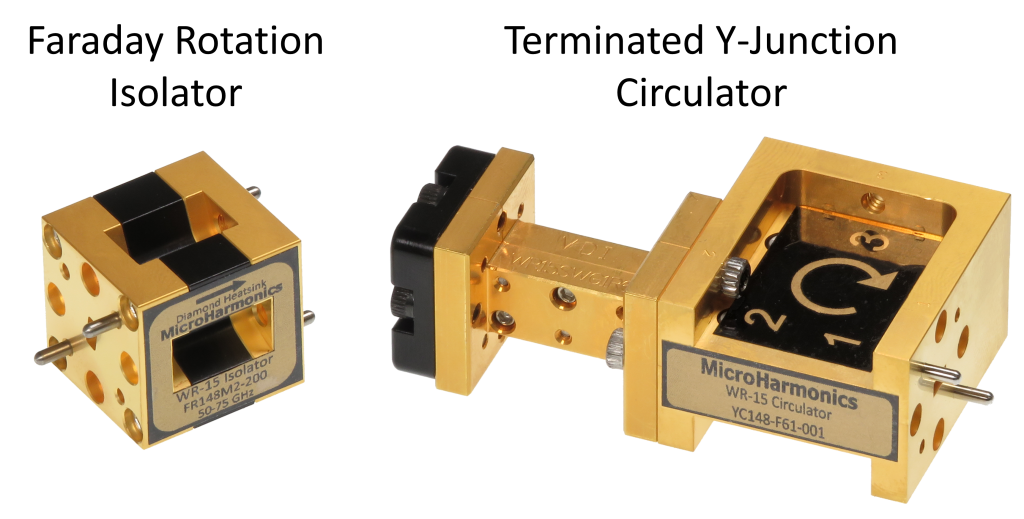Two Methods for Realizing Millimeter Wave Isolators
There are two fundamentally different techniques for designing isolators at millimeter-wave (MMW) frequencies. Maybe you have noticed this if you ever wondered why some isolators are narrow-band and some operate across the full waveguide band. Or maybe you noticed that some isolators are built with a terminated third port and some only have two ports. These differences (and more) are a result of the divergent design principles between the Faraday rotation isolator and the terminated Y-junction circulator (which operates as an isolator). Below is a short comparison between the two types of isolators.
Principle of Operation
A Faraday rotation isolator, as its name suggests, utilizes the principle of Faraday rotation, whereby the RF signal polarity rotates as it passes through a magnetized ferrite rod. In order to achieve optimal performance, the polarity of the signal must be rotated exactly 45°. The ferrite material causes the rotation to be nonreciprocal so that the forward traveling signal is coupled from port 1 to port 2 while the reverse traveling signal is not coupled but rather absorbed in an internal resistive layer.
By terminating one port of a circulator with a matched load, the resultant “two port device” operates as an isolator. Analysis of (terminated) Y-junction circulators is far more complicated. One school of thought is that Y-junction circulators operate in a turnstile mode whereby a signal entering the Y-junction splits equally along two paths. One signal propagates clockwise around the periphery of the ferrite while the other signal propagates counterclockwise. The ferrite creates disparate propagation constants along these two paths. The two signals propagate as linearly polarized waves which recombine in various polarizations and phases at the other two waveguides.
Bandwidth
The Faraday rotation isolator is inherently broadband so long as the frequencies of operation are far from the Lamour frequency. This is because the rate of signal rotation is largely independent of frequency. In other words, two signals propagating through a Faraday rotation isolator with frequencies at opposite ends of a waveguide band undergo nearly the same amount of polarization rotation.
In a Y-junction circulator, however, the splitting and recombining process is much more frequency dependent. The many required conditions for circulation cannot be met over broad bandwidths. This constraint limits the bandwidth of the component as frequency increases. For example, a typical bandwidth for a Y-junction circulator is about 6 GHz at WR-15 (50-75 GHz), 5 GHz at WR-10 (75-110 GHz), and 4 GHz at WR-8 (90-140 GHz).
Frequency coverage
Micro Harmonics manufactures Faraday rotation isolators up to WR-2.8 (280-400 GHz), which is the highest frequency isolator on the market. As frequency increases, the constituent parts become smaller and more difficult to fabricate. The main limitations to manufacturing at higher frequencies are the tight machining and tolerancing requirements, as well as the sensitivity to misalignment of the subcomponents during assembly.
Terminated Y-junction circulators are extremely sensitive to the tuning (size) of the ferrite core and, as previously discussed, their bandwidth decreases as frequency increases. The maximum frequency for terminated Y-junction circulators on the commercial market is around 140 GHz.
Performance
The isolation for a Faraday rotation isolator is typically between 20 dB and 30 dB over a full rectangular waveguide band. The isolation for a terminated Y-junction circulator is typically around 16 dB to more than 20 dB, depending on how the circulator is tuned, with increased isolation coming at the expense of decreased bandwidth. In the past, terminated Y-junction circulators offered much lower insertion loss than Faraday rotation isolators.
However, Micro Harmonics has redesigned the Faraday rotation isolator in a way that yields substantially lower insertion loss. The insertion loss of a Micro Harmonics Faraday rotation isolator is within a few tenths of a dB of the terminated Y-junction circulator. The port reflections of the Faraday rotation isolator are typically between 15 dB and 18 dB, whereas the port reflections for a terminated Y-junction circulator are typically a few dB better, but only over a narrow bandwidth.
Power Handling
Micro Harmonics utilizes a unique diamond heat sink in the design of its Faraday rotation isolators which allows them to handle substantially more RF power than competing products. Most MMW sources are not able to generate enough power to damage a Micro Harmonics isolator. One exception is a travelling wave tube amplifier (TWTA), often used for military applications. In this application, a Y-junction circulator with a well terminated port may be required.
Size
Most Faraday rotation isolators are larger and bulkier than terminated Y-junction circulators. But this is not the case with respect to the Micro Harmonics isolators which have a substantially smaller footprint. The width and height are 0.75 inches (the same size as the UG-385 or UG-387 flanges) and the lengths vary from about 0.5 inches to 1.5 inches depending on the frequency band. A terminated Y-junction circulator will be a little wider and roughly double or triple the volume.
Cost
Most of the cost of manufacturing millimeter wave isolators is associated with the fabrication of the metal plates, ferrite rods, and ceramic cones. The more numerous and intricate the features, the more expensive the part. For the same quantity, the machining cost of a Faraday rotation isolator and a terminated Y-junction circulator are similar.
Summary
In the realm of millimeter-wave isolators, we’ve delved into the key distinctions between Faraday rotation isolators and terminated Y-junction circulators. These two methods are essential in millimeter-wave technology, and their differences impact principles of operation, bandwidth, performance, and more. Notably, Micro Harmonics has redefined the landscape by introducing innovative Faraday rotation isolators with lower insertion loss, higher power handling, and a compact, cost-effective design. If you’re in search of cutting-edge millimeter-wave isolators with the best performance, Micro Harmonics is your go-to solution. Explore our product range today and experience the future of millimeter-wave technology. Contact us today for more information!

